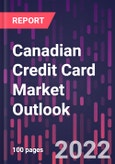The characteristics of the Canadian payments industry are determined by more than the competition among credit card and debit card issuers, the financial institutions and retailers, and consumer demographics. Payment trends also reflect consumer demands for transformative digital purchasing experiences and real-time payments, as well as the shifting pressures on card reward programs as consumers dialed down their in-store shopping and travel behaviors because of COVID-19.
Two years after the onset of the pandemic, total Canadian consumer spending has recovered to 2019 levels and the overall economy is on the road to full recovery, but the payments landscape remains altered with regard to where consumers spend their money, the channels used for spending money, and how consumers choose and interact with their payment products.
Canadian payment product and their rewards/loyalty program trends also track the Federal government's efforts to both push down interchange fees to benefit merchants and retain current levels of rewards to appease consumers. The government's push to move industry income in only one direction contravenes the historical pattern of card issuers collecting less in interchange and thereby lowering the value of rewards programs commensurately.
This all-new report reviews and analyzes the Canadian credit card market within the context of the $9 trillion Canadian payments market, covering transaction volumes and transaction values across product types and usage channels. It also examines emerging credit products, payment strategies, and buy-now, pay-later (BNPL) offerings of the Big Five banks, as well as those from financial technology companies (fintechs) and the card networks. The report also provides analysis of the partnerships between the big Canadian banks and their credit card co-branding partners, including retailers and airlines.
The information in Canadian Credit Card Market Outlook was obtained from primary and secondary research. Primary research included an extensive English/French proprietary online consumer survey - fielded in February 2022 - that assessed Canadian consumers use of payment products by type, frequency of use, demographics as well as the psychographics drivers of consumer choices. The survey is census representative of the primary demographic measures of age, gender, geographic region, race/ethnicity, and household income. Within the report, additional consumer surveys from other market research firms and payment providers are referenced and cited.
Secondary research also includes general business and trade publications, management consulting reports, investment analyst reports, company financial filings, and vendor-generated survey findings. Research also relied on Canadian and international governmental, non-profit, and not-for-profit trade reports; country profiles; and payment system analysis.
Two years after the onset of the pandemic, total Canadian consumer spending has recovered to 2019 levels and the overall economy is on the road to full recovery, but the payments landscape remains altered with regard to where consumers spend their money, the channels used for spending money, and how consumers choose and interact with their payment products.
Canadian payment product and their rewards/loyalty program trends also track the Federal government's efforts to both push down interchange fees to benefit merchants and retain current levels of rewards to appease consumers. The government's push to move industry income in only one direction contravenes the historical pattern of card issuers collecting less in interchange and thereby lowering the value of rewards programs commensurately.
This all-new report reviews and analyzes the Canadian credit card market within the context of the $9 trillion Canadian payments market, covering transaction volumes and transaction values across product types and usage channels. It also examines emerging credit products, payment strategies, and buy-now, pay-later (BNPL) offerings of the Big Five banks, as well as those from financial technology companies (fintechs) and the card networks. The report also provides analysis of the partnerships between the big Canadian banks and their credit card co-branding partners, including retailers and airlines.
Report Methodology
The information in Canadian Credit Card Market Outlook was obtained from primary and secondary research. Primary research included an extensive English/French proprietary online consumer survey - fielded in February 2022 - that assessed Canadian consumers use of payment products by type, frequency of use, demographics as well as the psychographics drivers of consumer choices. The survey is census representative of the primary demographic measures of age, gender, geographic region, race/ethnicity, and household income. Within the report, additional consumer surveys from other market research firms and payment providers are referenced and cited.
Secondary research also includes general business and trade publications, management consulting reports, investment analyst reports, company financial filings, and vendor-generated survey findings. Research also relied on Canadian and international governmental, non-profit, and not-for-profit trade reports; country profiles; and payment system analysis.
Table of Contents
Chapter 1: Executive Summary
Chapter 2: Overview of Canadian Payments
Chapter 3: Consumer Attitudes and Behavior
Chapter 4: Canadian Credit Card Issuers
Chapter 5: Retailer Credit Cards
Chapter 6: Canada’S Buy-Now, Pay-Later Industry








